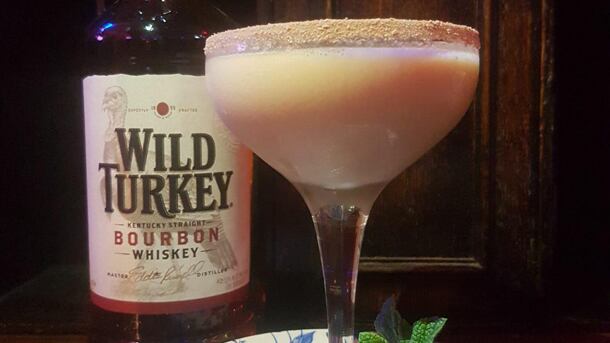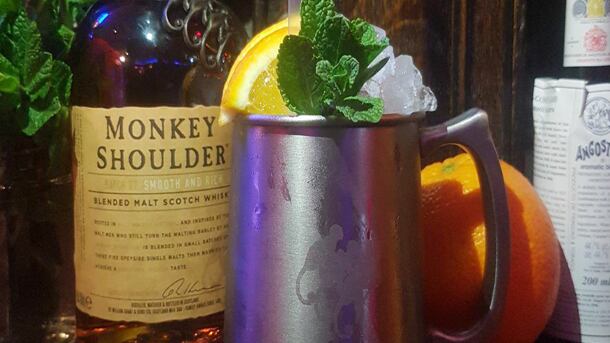
Enjoying whiskey comfortably
American whiskey continues to grow its share of on-trade spirits sales in both volume and value terms. With a heritage and provenance that appeals to premium spirits drinkers, the category is at the heart of classic cocktails such as the Old Fashioned, Whiskey Sour, Sazerac and Julep. In addition, the distinctive flavours of brands such as Buffalo Trace, Eagle Rare and Sazerac Rye offer a broad range of choice.
Whiskey’s depth of flavour can still be a challenge for some consumers. By offering a variety of serves, including neat, over ice and in cocktails and mixed drinks, licensees can help their customers find the way to enjoy whiskey that suits them best, and progress through the category.
This challenge is nothing new – back in 1874, New Orleans bartender MW Heron took the harsh whiskeys of the time and skilfully mixed them with his own blend of fruit and spices to create a whiskey that could be enjoyed comfortably.
That creation was Southern Comfort, and the newly launched Southern Comfort Black expression celebrates MW Heron’s vision – it has an authentic new whiskey-forward flavour to complement those iconic fruits and spices.
In creating Southern Comfort Black, master blender Drew Mayville had a resource that MW Heron would envy – he has many of the world’s finest whiskies from across the Sazerac business to work with. The result is a bold, 40% ABV premium spirit with a robust whiskey profile.
Southern Comfort Black on the back bar is an essential tool for licensees, easing their customers gently into the delights of American whiskey. As with gin, American whiskey is no longer a one-size-fits-all category for the on-trade. As part of a range that also includes mainstream, premium and speciality whiskies, and enjoyed across the full range of serves, Southern Comfort
Black can unlock the world of whiskey for consumers.
For further information visit www.hi-spirits.com
Think whisky and the first thing that springs to mind is most likely a tumbler of the amber spirit sat in the hand of an older gentleman, alongside a jug of water.
Not any more. Operators can easily change this perception of the spirit and boost its sales and appeal to a wider market, by not just thinking about all types of whisky as one sector, but by looking at the variety in category.
Some 12% of UK consumers drink whisky when imbibing in the on-trade, equating to 5.8m people, according to data expert CGA. But operators need to do more to keep the category at the forefront of drinkers’ minds.
CGA commercial director Graeme Loudon says: “The Scotch category continues to offer a polarised performance. Although total Scotch whisky is in 6% volume decline, which is mainly driven by mainstream blends, growth is being achieved by malt whisky (up 1.4% volume growth) and super premium blends.
“The trend of premiumisation is not new to the on-trade and the Scotch category is a good example of this trend at work.
“Malts account for just 23% of Scotch volume, but its higher price point means it commands 32% of the value.
“Consumers are trading up into super premium blends or even into malts as their palate matures and have been moving out of mainstream blends – this drives value ahead of volume. Having said this, the mainstream blend market is by far the biggest sector of the Scotch market and accounts for the majority of the volume.”
Loudon adds that influence from outside the pub industry is playing a big part in pushing growth in whiskies alongside fans of a particular type of beer.
He adds: “The popularity of Scotch has been reinforced by TV shows such as Mad Men, which is bringing the category to a new generation of drinkers and helping the category deliver a cool edge.
“There is also a strong crossover between Scotch drinkers and drinkers of craft beer and, as a result, we are seeing brands that traditionally have more challenging flavours within Scotch do particularly well as consumers see the challenging flavours as a badge of honour, similar to what we see in craft beer.”
In fact, craft beer creates opportunities for whisky in more ways than one, according to drinks supplier Maxxium UK, which has whisky brands including The Famous Grouse, Teacher’s and Jim Beam.
Marketing director Gareth Brown says: “The rise of craft beer is a trend consumers continue to engage with. The notion of ‘craft’ presents huge potential for the whisky category to step up and build status as a mixable spirit. We are also seeing a huge rise in the use of pre-batch and draught cocktails as this method of preparing cocktails frees up bartender time and provides serve consistency when done properly.”
Consumer transition
Popular choices
A survey of whisky drinkers revealed the styles consumed (respondents could give more than one choice)
1 Malt (50%)
2 American (47%)
3 Irish (40%)
4 Blended (32%)
Figures from CGA BrandTrack February 2017 report
American whiskey has a big part to play in transitioning consumers into the wider category, and has long been the go-to for many punters who buy into the category. In value terms, American is the largest segment within the whiskey category. There is also a lot of experimentation from US producers, who are moving the category upmarket into premium, which is seeing strong growth. American whiskey has performed particularly well when it comes to mixing with soft drinks and in cocktails, which, arguably, Scotch and Irish whiskey have had trouble with.
Southern Comfort brand ambassador Christian Tirel (see Enjoying whiskey comfortably) says: “By offering a variety of serves, including neat, over ice and in cocktails and mixed drinks, licensees can help their customers find the way to enjoy whiskey that suits them best, and progress through the category.”
However, that said, British tradition does still have a part of the whisky category but with a twist – removing the age of the spirit from packaging.
Loudon adds: “Malt whisky continues to go from strength to strength with outlets typically offering a range of products covering a number of different flavour profiles in order to satisfy different consumer tastes.
“We have also seen the rise in non-age statement whisky (when the bottle does not have an age on) brands, with a number of these products trying to move away from traditional age statement as a sign of quality and keeping tasting notes secret in order to drive interest from consumers.
“Consumers have responded particularly well to the non-age statement malts as brands are able to offer a quality, great-tasting liquid, which is ultimately becoming more important to consumers than an age statement.”
Well-known brands are to blame for a fall in volume for the blended whisky sector, according to Loudon.
“Blends is a category, which also demonstrates a polarising performance. Category volume is currently down 7.4% with the more established brands driving this top-line decline in the category,” he says.
“These behemoths of brands in these categories are distributed widely across the trade and, as a result, over-index in outlets that have closed over the past few years.
“This directly impacts the volumes of these brands and this category, as fundamentally there are fewer outlets from which these brands can gain volume.
“We have begun to see strong growth within the super-premium blends market that consumers are looking to, albeit this represents less than 1% of all blended volumes.
“With the growth in non-age statement malts, it will be interesting to see if consumers of these products are happy to switch back to blends and this could see a small revival in the blended Scotch category.”
Looking overseas
Two crazy cocktails
The Mad Hatter, Oxford
Speakeasy cocktail bar the Mad Hatter serves unique drinks in a variety of different ways and plays well into the hands of the whisky drinkers with these two concoctions:

Cheshire Monkey
Monkey Shoulder Scotch whisky, crème d’abricot, orange juice, lemon juice, Earl
Grey syrup, orange bitters and Angostura Bitters.
Built over crushed ice, beautifully balanced.
Jub Jub and Bandersnatch

Wild Turkey 81 Bourbon, Tia Maria, chocolate liqueur, half cream, egg white and vanilla syrup.
An indulgent pick me up!
Shaken over cubed ice and fine-strained into a coupe with a burnt chocolate garnish.
Though premium is one area operators can explore to boost whisky sales, one licensee suggests looking across the continents to offer drinkers something a little different, which proves Loudon’s point about mainsteam brands becoming less popular.
Tom Proud from Great British Pub Award winner pub Pleased to Meet You and Lady Greys, both in Newcastle, says: “There are lots of opportunities with whisky for mixed drinks and cocktails if a venue has flexibility, but if it doesn’t, there are still lots of things to do.
“One of the main things needed is a relatively broad selection. Even half a dozen whiskies work if they are chosen carefully.”
“Whisky is global now. You can get great whiskies from Taiwan, France, Sweden and New Zealand to name just a few.
“There’s no harm in having a guest bottle, something like a ‘malt of the month’, but it should be from somewhere farther away than Scotland because there are so many good whiskies out there.”
He adds that the secret behind having a great whisky offer is mixing the old with the new to provide consumers with a choice, but not overwhelmingly so.
“With whisky alone, the key is providing new and interesting serves alongside classics such as Manhattan or Old Fashioned cocktails, that you don’t need a lot of space for and can serve in most bars,” Proud says.
Combining contemporary and traditional themes is also something co-founder of Inception Group Charlie Gilkes echoes. He says: “Using innovative ways to serve whisky ensure that this great, yet complicated, spirit can be introduced to those who may be less adventurous with their spirit of choice.
“Across Inception Group venues we use sweet syrups such as maple and date in whisky cocktails to bring out the flavours.”
Gilkes also highlighted how whisky has distanced itself from its association with an older, male generation – who traditionally drank the spirit neat – thanks to cocktails.
He adds: “Whisky has already started to move away from this reputation. This is due to classic cocktails such as Rob Roy, Manhattan, Old Fashioned and Whisky Sour becoming much more popular again.
“Bartenders are now using whisky in more innovative cocktails, making use of new techniques such as smoke guns, flavour reductions and home-made bitters. This allows
the true soul of the whisky to come through, while ensuring those who are less likely to choose whisky as their spirit of choice, an opportunity to taste the ‘water of life’.”
The change in the market towards lighter whiskies also means bar staff especially have more scope to experiment with the spirit in mixed drinks.
Using more delicate whiskies
Gilkes says: “Whisky has always been an adventurous spirit, however, also a classic at the same time. Following a boom in the whisky market worldwide, whisky distilleries began to introduce lighter and more delicate whiskies into the market.
“This then allowed bars to create intriguing concoctions without having to overcome the strong taste and smokiness often associated with whisky.
“This means that a wider audience has been targeted, allowing for more experimentation with whisky cocktails and, of course, this helps your cash margin.”
Experimentation is important across all categories and ensuring flavours match is crucial, but what about pairing spirits with dishes?
Food and drink pairing is something that beer and wine do particularly well, however, Maxxium’s Brown outlines how whisky can jump on this bandwagon too, meaning operators who concentrate on their food offer can also have a piece of the pie.
He says: “We continue to see an increase in consumers choosing to pair their spirit and cocktail consumption with an eating occasion, the growth of the food-led sector is a clear example of this trend.
“This new drinking occasion unlocks huge potential for the whisky category to detach from the notion that it should in fact, always be served neat.”
“Consumers who order whisky often do so as an additional drink, whether that’s alongside a dessert or hot drink and is, therefore, seen as an additional purchase but also a product with higher margins for operators.
“The increase in popularity of whisky flights also allows operators to offer consumers a range of whiskies while ultimately selling more than one serve in a single transaction.
“Once an outlet is successful in bringing whisky consumers on board, the opportunity to upsell into aged statement alternatives with higher-value increases, ultimately supports the bottom line for the operator.
“Although whisky flights and additional serves offer options for many existing whisky drinkers, we must continue to grow the category by offering new whisky consumers various options.”
Whether it is offering a premium serve, pairing with food or having a plethora of varieties on the back bar, operators need to tap into one of these key trends in order to get rid of the ‘neat’ whisky image.
